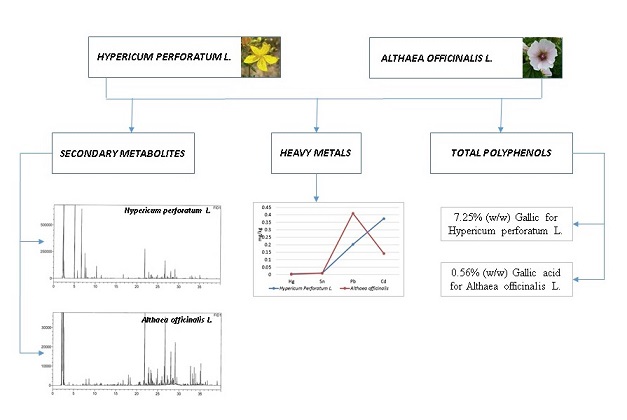[1] J. Asgarpanah, Phytochemistry, pharmacology and medicinal properties of Hypericum perforatum L,
African Journal of Pharmacy and Pharmacology,
2012,
6, 1387-1394. [
Crossref], [
Google Scholar], [
Publisher]
[2] A. Alahmad, I. Alghoraibi, R. Zein, S. Kraft, G. Dräger, J.G. Walter, T. Scheper, Identification of major constituents of Hypericum perforatum L. extracts in Syria by development of a rapid, simple, and reproducible HPLC-ESI-Q-TOF MS analysis and their antioxidant activities,
ACS Omega,
2022,
7, 13475-13493. [
Crossref], [
Google Scholar], [
Publisher]
[3] V. Hadzhiiliev, D. Dimov, Separate isolation of hyperforin from hypericum perforatum (St. John’s Wort) pursuant to the coefficents LOG Kow, PKa and densities of the included compounds,
Trakia Journal of Sciences,
2015,
13, 19-23. [
Crossref], [
Google Scholar], [
Publisher]
[4] J. Patocka, The chemistry, pharmacology, and toxicology of the biologically active constituents of the herb Hypericum perforatum L,
Journal of Applied Biomedicine,
2003,
1, 61-70. [
Crossref], [
Google Scholar], [
Publisher]
[5] L. Verotta, G. Appendino, J. Jakupovic, E. Bombardelli, Hyperforin analogues from St. John's wort (Hypericum perforatum),
Journal of Natural Products,
2000,
63, 412-415. [
Crossref], [
Google Scholar], [
Publisher]
[6] M. Mahboubi, Marsh mallow (Althaea officinalis L.) and its potency in the treatment of cough,
Complementary Medicine Research,
2020,
27, 174-183. [
Crossref], [
Google Scholar], [
Publisher]
[7] S.S. Gautam, S. Kumar, R. Chauhan, Antimicrobial efficacy of Althaea officinalis Linn. seed extracts and essential oil against respiratory tract pathogens,
Journal of Applied Pharmaceutical Science,
2015,
5, 115-119. [
Crossref], [
Google Scholar], [
Publisher]
[8] M. Valiei, A. Shafaghat, F. Salimi, Chemical composition and antimicrobial activity of the flower and root hexane extracts of Althaea officinalis in Northwest Iran,
Journal of Medicinal Plants Research,
2011,
5, 6972-6976. [
Crossref], [
Google Scholar], [
Publisher]
[9] N. Adiputra, I.G.M. Aman, I.B.P. Manuaba, The toxicity of antiviral plants used in Balinese traditional medicine,
Bali Medical Journal,
2017,
6, 243-246. [
Crossref], [
Google Scholar], [
Publisher]
[10] S. Kilic, I.B. Cam, T. Tongur, M. Kilic, Health risk assessment of exposure to heavy metals and aflatoxins via dietary intake of dried red pepper from marketplaces in Antalya, Southern Turkey,
Journal of Food Science,
2018,
83, 2675-2681. [
Crossref], [
Google Scholar], [
Publisher]
[11] H. Mawarti, M. Rajin, Z. Khusniyah, Z. Asumta, C.D.W. Wijayanti, Aloe vera and its potency as antituberculosis against strains of Mycobacterium tuberculosis that is resistant to some tuberculosis drugs,
Bali Medical Journal,
2022,
11, 1879-1883. [
Crossref], [
Google Scholar], [
Publisher]
[12] M. Babu-Kasimala, M. Tukue, R. Ermias, Phytochemical screening and antibacterial activity of two common terresterial medicinal plants Ruta chalepensis and Rumex nervosus,
Bali Medical Journal,
2014,
3, 116-121. [
Crossref], [
Google Scholar], [
Publisher]
[13] P.H. Laswati, I., Subadi, M. Andriana, A,P. Maria, J. Alex Pangkahila, Tomato (Lycopersicum Commune) juice and physical exercise increase number of neurons and ERβ expression in post-ovariectomy rats brain,
Bali Medical Journal (Bali Med J),
2016,
5, 84-91. [
Crossref], [
Google Scholar], [
Publisher]
[14] A. Cakir, M.E. Duru, M. Harmandar, R. Ciriminna, S. Passannanti, F. Piozzi, Comparison of the volatile oils of Hypericum scabrum L. and Hypericum perforatum L. from Turkey,
Flavour and Fragrance Journal,
1997,
12, 285-287. [
Crossref], [
Google Scholar], [
Publisher]
[15] A. Shabani, M. Karapandzova, I.C. Karanfilova, G. Stefkov, S. Kulevanova, GC-MS analysis of the essential oil, aroma components and n-hexane extract of St. John Wort (Hypericum perforatum L., Hypericaceae),
Macedonian Pharmaceutical Bulletin,
2018,
64. [
Crossref], [
Google Scholar], [
Publisher]
[16] Q. Du, Y. Cai, Z. Chen, D. Wei, Y. Cao, Y. Chen, S. Yu, Q. Zhao, J. Wu, M. Liu, Determination of Trace Elements in Corydalis conspersa and Corydalis linarioides by ICP-AES,
Journal of Chemistry,
2020,
2020, 1-11. [
Crossref], [
Google Scholar], [
Publisher]
[17] Y.Q. Liu, X. Shao, L.L. Qu, ICP-AES determination of 11 kinds of elements in high grade pipeline steel,
Advanced Materials Research,
2012,
455, 830-833. [
Crossref], [
Google Scholar], [
Publisher]
[18] L.H. Jia, Y. Liu, Y.Z. Li, Determination of the major metal elements including heavy metals in Saffron from Tibet and Henan by ICPAES or ICP-MS,
Journal of Chinese Pharmaceutical Sciences,
2011,
20, pp.297-301. [
Crossref], [
Google Scholar], [
Publisher]
[19] M.I. Prawira-Atmaja, H.S. Khomaini, H. Maulana, S. Harianto, D. Rohdiana, March. Changes in chlorophyll and polyphenols content in Camellia sinensis var. sinensis at different stage of leaf maturity, In
IOP Conference Series, Earth and Environmental Science IOP Publishing, 2018,
131, 12010. [
Crossref], [
Google Scholar], [
Publisher]
[20] R. Aditya, B. Santoso, W. Widjiati, Comparative study of bioactive compound content and antioxidant activity in different extraction methods of Syzygium Polyanthum leaves,
Bali Medical Journal,
2023,
12, 3425-3430.[
Crossref], [
Google Scholar], [
Publisher]
[21] N.A. Korotkova, V.B. Baranovskaya, K.V. Petrova, Microwave digestion and ICP-MS determination of major and trace elements in waste Sm-Co magnets,
Metals,
2022,
12, 1308. [
Crossref], [
Google Scholar], [
Publisher]


